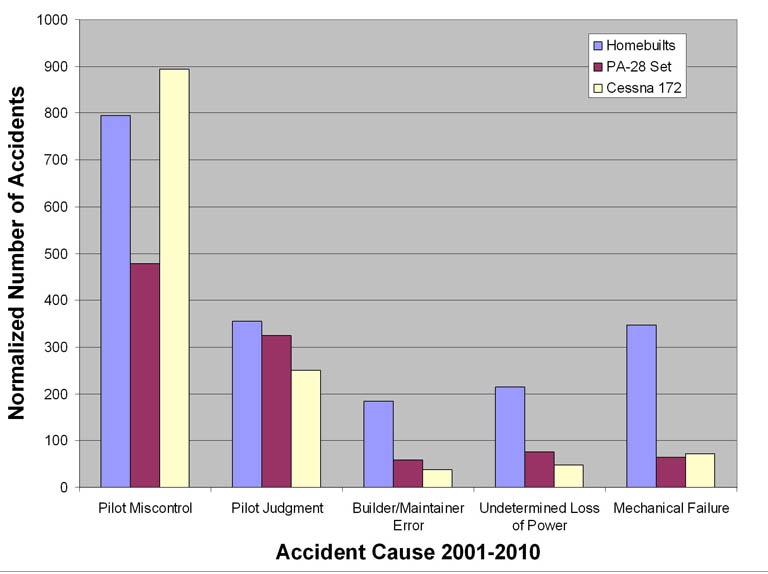So, the accident rate for EAB is higher than for certified aircraft, the data is pretty clear on that.
Well... the problem is, there really isn't any good, clear data. All the comparisons of homebuilt vs. production accident rates depend on a number of assumptions, and the results can change quite a bit depending on how one slices the assumptions.
Let's pick on Jay for a moment (can't argue with tradition

. When he owned his Pathfinder, the FAA assumed he was flying it about 200 hours per year when it came time to predict the total GA flight annual flight hours. Now that he owns an Experimental Amateur-Built aircraft, the FAA assumes he flies 29 hours per year.
Now, spiffy flight suit and new kneeboard aside, the RV-8 hasn't changed Jay and Mary's use of aircraft that much. There'll be more hours this year, of course, but once they settle into ownership, they'll probably fly about the same number of hours.
But the FAA doesn't see it that way. When they estimate the total fleet hours for the homebuilt and certified aircraft at the end of year, Jay's RV-8A will count for less than 30 hours of flying time.
The explanation I received is that this is compensating for the inactive homebuilts on the rolls; that Jay's airplane essentially represents "N" homebuilts, and the numbers are averaged out.
But, again, a stream of assumptions. The FAA registration database is in sad shape, though the re-registration process helps to some extent. There are thousands, perhaps over ten thousand, homebuilts on the FAA registry that are not counted as such.
~25 years ago, a friend of mine built an RV-6: N16JA. Look up its registration. Guess what, it's not a homebuilt. Classification is "unknown," not Experimental, and its category is "None" instead of Amateur-Built.
Now, look up N16JA in the NTSB records. An accident in 2004 (well after my friend sold it, I hasten to add).
You want to BET that N16JA was listed as a homebuilt in the 2004 accident statistics, even though it wasn't otherwise counted as a homebuilt? So the homebuilt accident rate gets its numerator incremented, without the denominator reflecting the additional aircraft.
I went through the FAA rolls a while back, and found about 11,000 aircraft with homebuilt-like names that were not listed as Experimental. That's about 1/3 the number of airplanes in the officially-recognized homebuilt fleet. No question the statistics would look better if they were included.
Another factor is that the FAA/NTSB/AOPA aren't considering
comparable use. A Kitfox and a Mooney do NOT have the same mission. Their accident rates are undoubtedly different, but the question is, how much is the "homebuilt" nature of the Kitfox contributing to its rate? How about the little grass strips it flies into, or the series of touch-and-goes the owner flies? Can we blame a higher accident rate solely on the fact that the Kitfox doesn't comply with standard airworthiness?
You really shouldn't. But that's the way its done. A combination of a string of assumptions, coupled with some *missing* assumptions, and we can't really narrow down on the difference in the accident rates.
I've done the comparison myself, using solely the fleet size of the aircraft types. It has its problems as well; many of the aircraft listed are non-existent or inactive...on both sides of the airworthiness coin. But it probably has the shortest string of assumptions.
The last time I ran the Overall vs. Homebuilt comparison (a number of years ago), homebuilts had a 43% higher accident rate, dropping to about 16% if aircraft still in their test periods were not included. AOPA, in their annual Nall report, says the homebuilt accident rate is about seven times higher than production-type aircraft. The truth no doubt lies somewhere in the middle.
Ron Wanttaja


 You misread, misunderstood and misrepresent what Jay said. Not useful. Stick to trying to stay awake while you rack up all these so-called hours you like to think make your opinion so valuable......
You misread, misunderstood and misrepresent what Jay said. Not useful. Stick to trying to stay awake while you rack up all these so-called hours you like to think make your opinion so valuable......





